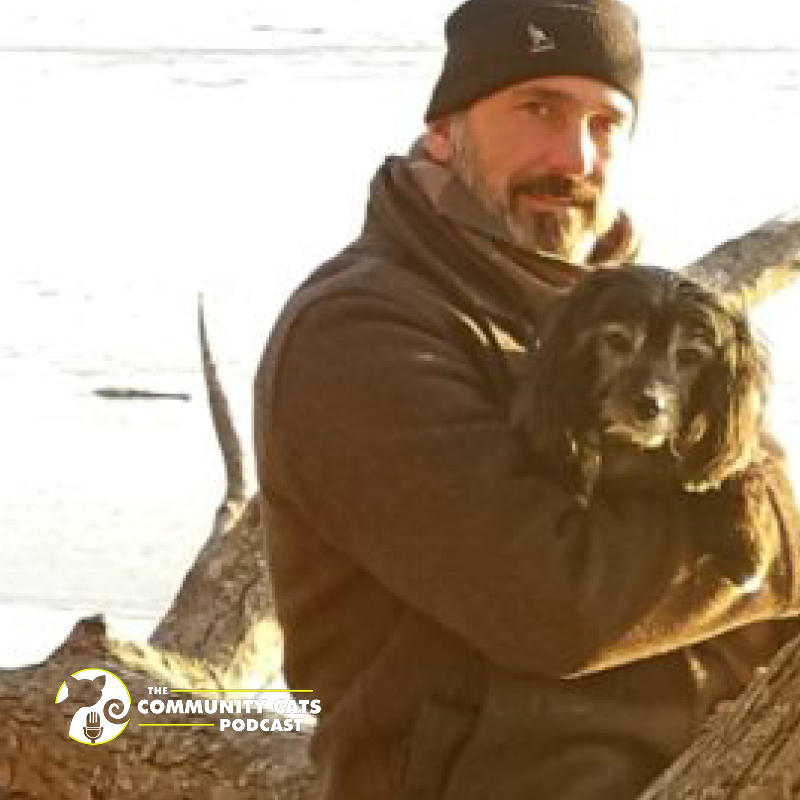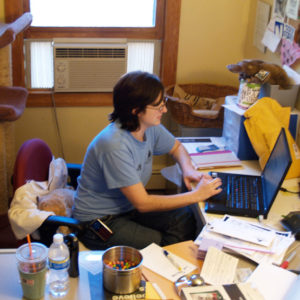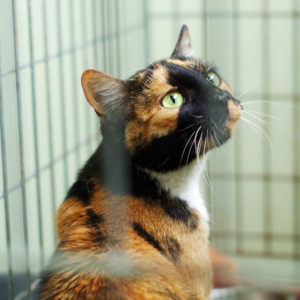
Steven Mornelli, Waggle
June 30, 2020
Ashley Shoults, Animal Arts
July 7, 2020
This week’s guest post comes to us from Liz Pease, former Executive Director of the Merrimack River Feline Rescue Society, who was featured on CCP Episode #51.
This week, I’m starting with a tale from my decade at the Merrimack River Feline Rescue Society (MRFRS) in Salisbury, MA. Since the 4th of July is nearly upon us, I’ll start with a story about fireworks and lost pets. This is one of those animal welfare legends that you’ll see popping up in memes everywhere this time of year: that more pets are lost around Independence Day than any other time of year. Is it true? It’s hard to say, at least when it comes to cats, though there is no question that fireworks are terrifying to pets, as well as to many humans. Either way, those memes are always a good opener for a subject that’s definitely worth talking about: how we can work to reduce the numbers of lost pets and increase return-to-owner rates.
First, the story: MRFRS is located about three miles from a busy oceanfront area that normally hosts fireworks, concerts, and other events from Memorial Day through Labor Day.
A number of years ago, on a steamy hot day Monday (a day the shelter is closed to the public) after the 4th of July weekend, I was contacted through a round-about, someone-who-knew-someone-who-knew-me way by a resident of Salisbury Beach who had found a cat trapped in the wheel well of his car.
 At the time, we didn’t have an animal control officer who was interested in working with cats, so I did what I always did: grabbed my bite gloves, a net, a trap, a carrier, and hopped in my car. Upon arriving, the caller met me and showed me the cat, who was, indeed, lodged inside one back wheel well of the car, his front leg somehow wrapped over the wheel, trapped between the wheel and the brake pad. It seemed clear that the overweight black and white cat had been trying to get up inside the car (perhaps to hide) and had become stuck in the process. After a quick thank you to the universe that the caller had somehow noticed this cat instead of just hopping in his car and driving off, he and I set about figuring out how to free the cat. I knew I also needed to somehow corral the cat after we freed him.
At the time, we didn’t have an animal control officer who was interested in working with cats, so I did what I always did: grabbed my bite gloves, a net, a trap, a carrier, and hopped in my car. Upon arriving, the caller met me and showed me the cat, who was, indeed, lodged inside one back wheel well of the car, his front leg somehow wrapped over the wheel, trapped between the wheel and the brake pad. It seemed clear that the overweight black and white cat had been trying to get up inside the car (perhaps to hide) and had become stuck in the process. After a quick thank you to the universe that the caller had somehow noticed this cat instead of just hopping in his car and driving off, he and I set about figuring out how to free the cat. I knew I also needed to somehow corral the cat after we freed him.
We tried everything safe we could think of—and not one thing worked in the slightest. There simply was no room to maneuver the cat. It became clear that the only option was going to be to lift the car. The caller quickly gathered several acquaintances and together, while I lay on the ground beside the car, they lifted it just enough that I was able to remove the cat’s leg from under the brake pad.
That was actually the easy part. It was getting the cat in a carrier that I was worried about. It was one of those moments that everyone in animal welfare has experienced, where the only thought in your head is “I have one shot at this, and if I let go, this cat is gone. There is no other option than this working.” In those moments, you take a deep breath, try to channel some Zen energy, and then you hold on, no matter what. And that is exactly what I did, scooping the terrified creature into a top-loading carrier and slamming the door shut before he had a chance to take off. The bystanders were amazed—with the lifting of the car and with the fact that I was able to hold on to the cat—and we all felt great. Except for one thing: we didn’t know who this cat belonged to. He clearly belonged to someone, but no-one there knew him. This was well before Return-to-Field, and besides, I needed to make sure the cat was unhurt and not overly dehydrated. So back to the shelter we went.
 We examined him (no apparent injuries and no worse for wear other than a lot of dirt and grease), scanned him for a microchip (none to be found), then popped him with FVRCP, treated him for fleas and microchipped him, per shelter protocol. I named him Wheelie.
We examined him (no apparent injuries and no worse for wear other than a lot of dirt and grease), scanned him for a microchip (none to be found), then popped him with FVRCP, treated him for fleas and microchipped him, per shelter protocol. I named him Wheelie.
The next day, having been closed to the public since Saturday afternoon, we took a call off the voicemail from a woman whose black and white cat had gone missing during the 4th of July fireworks. Terrified, he had broken through her screen door and taken off and she hadn’t seen him since.
Wheelie did indeed turn out to be her cat, and once our vet had had a chance to examine him, he went home with her. A happy ending, but could it have gone better?
I would say yes, it could have gone better, in many different ways. Let’s go through some of them.
Microchips
If Wheelie had had a microchip, we could have gotten him back to his owner immediately, instead of having to have him spend a night with us. In the shelter, he was exposed to all sorts of germs he didn’t need to encounter, and he was likely pretty stressed out. We could have avoided all that if he’d had a microchip (and if that theoretical microchip had been updated with current information).
If you work in animal welfare, you are likely a proponent of microchips already, but if you want to learn more about how they work and options that are available to shelters and rescues, check out CCP Episode 151 with Cheryl Fernandes of PetLink, who tells Stacy that “The microchip is the silent voice for the animal.” You can also find several CCP blog posts on the topic by entering the word “microchip” into the search bar on the CCP homepage.
 Systems for Matching Lost Pets and Intakes
Systems for Matching Lost Pets and Intakes
It goes without saying that we should have been doing a better job of checking voicemail messages on closed days at MRFRS back then (perhaps especially around the 4th of July). In this situation, it would have avoided a delay in reuniting Wheelie and his owner had we pulled her message off sooner than we did. I did put protocols into place for that at some point, but even still, getting a call from a lost pet’s owner only helps if the right person (someone who knows that cat is in the building, or who has a quick way of finding out) sees the message. That’s where a good software program, or at least an organized intake system of some kind, comes into play. Solid systems or good software will help you standardize how animals are described and will make sure you’re collecting the most useful information about each animal so that it can easily be matched with lost cat calls.
If you don’t know where to start with shelter software, listen to CCP Episode 289 with Elena Battles of ShelterLuv software. You might be surprised by what your shelter or rescue can afford. Even if you aren’t in a position to take on software right now, make sure that you have a standardized intake information sheet, and that everyone in your group is describing animals the same way. For instance, is a gray cat called gray or blue? Is a striped cat a tabby or a tiger? These things can make a big difference when trying to match up a caller’s description with a new intake.
 Fireworks Changes
Fireworks Changes
I strongly believe that we need to reconsider fireworks in this country. They are incredibly stressful to pets, wildlife, children, and folks with PTSD. There’s simply no need for them in this day and age, especially when we have the technology to do pretty incredible light and other displays. That said, I know they are beloved by many Americans, and not likely to go away any time soon. So, if there are fireworks in your area and you have cats, take some precautions. (I’m going to focus on cats here because dogs’ stress around fireworks, thunderstorms, etc. already gets quite a lot of attention.) Make sure your cats are microchipped, and that those chips have up-to-date information. Consider placing your cat(s) in a quiet room (away from the doors to the house!) with a closed door and good places to hide during the fireworks. Keep the windows closed and play some soft music or turn on a sound machine. Spray some Feliway or look into other ways to soothe stressed-out cats. Make sure everyone in your house knows the cat is nervous and remind them to be mindful of doors, and that they shouldn’t try to interact with the cat during the fireworks.
In the event your cat does escape, during fireworks or any time, we have lots of tips for you. My CCP blog post “Have a Missing Cat? Do These Things First,” is a good place to start. You might also check out CCP Episode 15 with Brigid Wasson from the Missing Pet Partnership, and Episode 248 with Kim Freeman, lost pet finder, for more ideas and resources.
Of course, this year, many of our local 4th of July celebrations—including fireworks displays—won’t be happening due to the COVID-19 pandemic. As a mom to four cats, two chickens, and two small kids, I for one am OK with that. Either way, I hope you and your family members, furry and non-furry, have a wonderful, relaxing, safe holiday!

Liz Pease is the former Executive Director of the Merrimack River Feline Rescue Society and previously served as the Feral Cat Program Director and Director of Operations at MRFRS. She has been involved in animal welfare since 2004 when she TNRed her first feral cats.
Liz now works as an editor and proofreader and has been part of the CCP staff since 2018. She lives in Salisbury, MA with her husband and two small kids, plus four cats and two chickens—all of whom hang out together in their catio-turned-chicken-coop.




